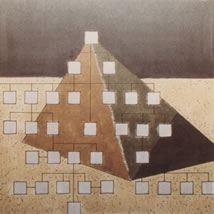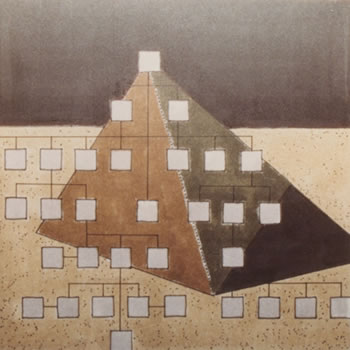Structure
Wins

|
Hierarachy
by Matt Taylor 1986
|
The
Use and Misuse of Hierarchy
|
NOTES
regarding this document:
|
|
“Structure
Wins” has long been a fundamental premise of Gail’s
and my work. For me, the insight goes back to my architectural
sensibilities and training. How the structure of
organization effects thinking and the ability to act -
both for
good
and bad - is an essential aspect of the design of any human
enterprise be it a philosophy organization, a product or a technology.
The MG Taylor IP rests on a cybernetic viewpoint of organization:
how is a mind, a ValueWeb, an economy, a work process
essentially
the same thing? From this perspective, structure and process
are not seen as separate. They are the same. The difference
between them is actually the time scale frame of the “participant”
making the distinction. A rock is a slow - from the
human perspective - moving process. An auto race is a
fast
changing structure.
Neither a rock nor an auto race can be understood without
looking at the layers of organization “above”
and “below” the scale which gives them their distinct
definition. Everything is connected to everything
else - we only isolate certain aspects of something we are interested in (thus, creating
a system)
for our convenience.
|
|
I
was prompted to write this paper following the events of September
11, 2001. 9/11 apparently was a great shock to the majority
of US citizens. Personally, I find this astounding.
Why
this is so and what experiences
[link: 1947]
I have lived, which provide me another perspective, provides
the basis for the essay that follows. This is an
issue of
“frame” - what is the system-in-focus
[link:system in focus] is
critical when looking at any issue of organization.
|
|
“Structure
Wins.” 9/11 was, in part, a clash between two
different organizational architectures. Usually,
when structure is discussed a hierarchy is assumed
- as if this
was organization. Hierarchy, of course, is just
one of many possible structures. Network architecture
is a major
alternative design strategy to what we have come to accept
as organizational structure. And, just to make it fun,
hierarchy will be found in networks
and
networks
in
hierarchies.
On
both a theoretical and operational level, organizations
are, in fact, far more complex and varied than our simple
default model of them suggests. This gets us in deep trouble
more often than not.
|
|
Far
too often, people fail to see organizational structure
as
a design issue. This means the most critical aspects
of any organization happens by default. The “unintended”
consequences can be devastating. Organizational architecture
must be approached carefully. The various design strategies,
such as hierarchy and network have to be carefully applied.
Organizational hierarchy is a powerful design tool. It
is
not organization itself. It can be effectively used to
accomplish human ends and it can be be used to destroy
everything that makes us human.
|
|
|
Structure
Wins

The
Use and Misuse of Hierarchy
|
|
|
The
hierarchy is a powerful organizational principle.
Most of human knowledge is organized in some form
a of a hierarchical structure. As are most human
institutions.
With the word “hierarchy” the Roman Army
and the Catholic Church come to mind. These are
two structures
which endured for centuries and successfully managed
great change.
|
|
Today,
the hierarchy is subject to great criticism [link].
This is particularly so in the realm of organizing
human business. This is, like so many things, a “true
and not true” charge. If better models of both
hierarchy and it’s alternatives are not employed,
many organizations will leap from the over-structured
frying pan into the poorly understood network-fire
with, sadly, predictable results.
|
|
As
important as this issue is on the level of business
it is far more critical in the exercise of political
power. Business get their feedback from the market
- at least they do when a truly free market is operating.
Governments exercise force as a mean of accomplishing
their goals. In fact, this is one of the principle
reasons for government: the delegation, by citizens,
some aspects of the exercise of their right of self
defense to a legitimate
body [link] who
will carry this function out on a social scale
and do this, assumedly, in a
just way.
|
|
When
government legitamacy and power is abused - and
it often is - the consequences
for millions of people are disastrous, and in this
case, the “market” finds it much more
difficult to provide effective feedback. If the armature
[link] of
the public commons is weak, there is little recourse
for those citizens who are disenfranchised by the
organization that rules their lives. Governments
can be great benefactors of humankind - they can
also
be a great scourge if not to their own citizens then
to others.
|
|
What
we are experiencing today is the beginning phases
of the breakdown of the Nation State. At present
there is nothing to replace this social invention.
The stresses
created by it’s own structure and successes
are causing it to fail nevertheless. How this transition
is handled is one of the most important
challenges [link] facing
humankind. In my view, it cannot be approached
- let alone resolved - within the framework
of the common understanding and use of organization.
|
| Our
attempted use of organization in our society far
outstrips our theory
of it - thus, our practice of organization,
in the sense of social commonwealth, is rapidly eroding.
It is doing so at a time when we
need it
the most - even as we approach the task of replacing
the organizational architecture we have in place with
one that will be more requite with present and future
times. We “adjust” economies without thinking
of and challenging their
fundamental structure. [link] We
fight just wars - “just”
from the framework of the last outrage done to us -
without exploring, understanding and admitting to the
past actions that prompted the attack; without understanding
the structural causes of the conflict - without thinking
seriously about how this “just” action
will provoke another
generations of violence. We watch huge corporations
rapidly ascend to prominence and
even
more rapidly
fall as we praise and then blame their CEOs as if it
were a sporting event; we do this without caring about
the
intrinsic
drivers [link] behind
these increasingly dangerous
oscillations [link].
There is always, in the public mind, the “issue
of the moment” jumped on by
the media, subjected to
spin-on-spin
by the politicos - the great distraction for a day,
a week or a month or two. These events polarize our
society
into debates usually two sided almost evenly divided.
Every aspect is covered except, of course, the deep
structural causes and long range consequences. Public
debate has
become
the modern version of the Roman Circus. Yes, we should
debate these issues. We should do so, however, in the
context of past and future history. We should do so
as one means of arriving at basis for resolution and
a foundation to design the means for better solutions
to emerge [link]. This “process” we now go through
is the result of social structures and, itself, a growing
construct of great influence. It saps the resources
and will to enter into reasoned dialog. It divides
our society and increases the perception of threat
and the idea that any of us of one persuasion must
- to survive - “win” over the other. |
| At
a time when the power of the Nation State may be
giving away to economic bio-regions, this is a dangerous
circumstance. We may be entering into a global civil
war between two radically opposed concepts of society
made more complicated by the members, particularly
on one side of this contest, feeling they have to
eliminate
any differences in their own camp. Religion, politics,
economics, ethnic groups and the institutions of
learning and science are becoming increasingly “Balkanized”
and are realigning with
each other across traditional borders breaking down
the basis of social
legitimacy [link].
The means of this struggle are become asymmetrical
[link]. The
architecture
of hierarchy cannot facilitate this transformation
It does not have the bandwidth nor the flexibility
required.
It
leads too easily to set positions and conflict -
be that conflict shouting heads on TV or the use
of massive military force against an “enemy” who in fact whose only “crime” has been to disagree with U.S. policy in a way that would be legal for an American citizen to do. |
|
The
Use of Network Architecture
|
The
Transformation of Organizational Architecture
|
rise_of_the_geopolitical_regional_economy |
A
Geopolitical Economy of Regions and ValueWebs
|
| It
is my best guess that the dominance of the nations
State is on the wane and will be replaced by
a new network structure made up of economic
bio-regions. These will be “replacement economies”
as Jane Jacobs defines them. Global ValueWebs
will span across these regions and local webs
will reside within them. These will be the true
instruments of wealth creation/distribution and
intellectual/business transaction. Cultures will
span these ValueWebs and visa versa. The cultures
will reflect what today we understand as the
state but will be more fine grained. The Nations
State will become a BRAND - a place -
more than a political entity and many exiting
Nation States
will fragment into historic and ethnic enclaves.
People will be local and global - ethnic uniqueness
and global citizenship will both be celebrated.
The hard lines between government, business and
NGOs will become blurred, from a traditional
viewpoint, but discrete and functional in actuality.
Network architecture will prevail and network
behavior will be the dominate characteristic.
In this architecture, war will have little utility.
Hierarchy, when it appears, will be a deliberately
employed organizational design strategy that
is a sub-system of an overall network architecture.
The predominate human organizational modality
will be affiliation to personally selected affinity-based
networks which will cut across all traditional
organizational categories. The structure of these
pathways and nodes will look much like the neural
map of the human brain itself. These connections
will tend to be ad-hoc, changing as an individual’s
and communities’ of practice circumstances change.
All of the organizational strategies employed
by humankind, for 10,000 years, will be seen
in the constantly pulsing, swirling flux of human
intercourse. This will be a knowledge-based,
hunter-gather society characterized my constant
migration and long term “home” affinities.
It will be extraordinarily flexible and stable.
The ability to DESIGN will be the premier
talent. People will have the maximum ability
to find and shape the lifetyle-place that fits
their values. The range of this social experimentation
will be broad; from traditional enclaves
to those that barely seem human from a 20th Century
perspective. The most predominate ethic will
be the acceptance and respect rendered all of
these alternative social constructs. |
| This
social architecture constitutes and massive transformation
from that which exists today (2005). This transformation
will be driven [link] by
a number of factors and a stark reality: the
fact that the social architecture of the 20th
Century leads to war, economic division (and,
ultimately collapse), environmental deterioration,
and a dead end for human development and spirit.
In the transition phase, this new architecture
will be “practiced” into reality by a global
effort to integrate human economy with Gaian
ecology to recreate Earth as a garden to be enjoyed
by all life forms [link].
This will be so because the alternative is too
horrific to ponder. |
|
Matt
Taylor
Palo Alto
September 22, 2001

SolutionBox
voice of this document:
INSIGHT • POLICY • PROGRAM
|
Posted:
September 22, 2001
revised:
October 20, 2008
• 20010922.816302.mt • 20020414.120965.mt •
• 20030327.222200.mt •
20050701.345600.mt •
• 20081020.6361108.mt •
(note:
this document is about 20% finished)
Copyright©
Matt Taylor 1986, 2001, 2002,
2003, 2005, 2008
|
|
|